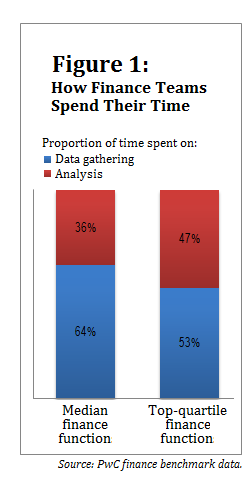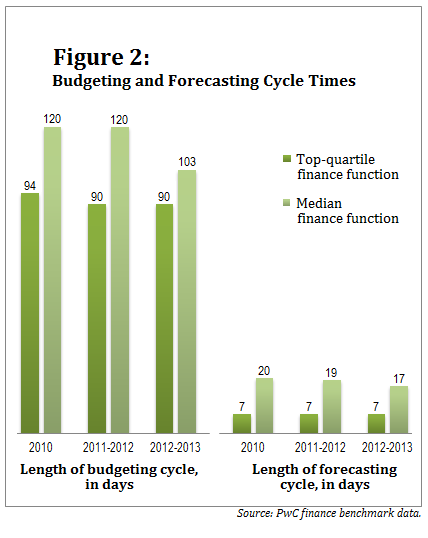In its recent report “UnlockingPotential: Finance effectiveness benchmark study 2013,” PwCbenchmarked the finance functions of more than 200 companies basedon their performance in everything from the quality of theirbudgets and financial forecasts to the efficiency of theirtransactional processes to their effectiveness in treasury, riskmanagement, tax compliance, and audit. Then it grouped the financeteams into quartiles and compared them across a variety ofcharacteristics.
In terms of efficiency, the survey found that the cost offinance for top-quartile businesses is 0.56 percent of corporaterevenue. For the median company, that number is 0.93 percent—so theproportion of corporate revenue that goes toward finance costs isnearly two-thirds higher for the typical finance function than fortop teams.
|Moreover, leading finance functions are using their slice of thebudget to do a lot more analysis. In the median company, thefinance team spends nearly two-thirds of their time on datagathering and just over one-third on analysis. For top-quartilefinance teams, that ratio is much closer to 50:50 (see Figure1).
|Performance management is one area that seems to drag down thetypical finance organization. Budgeting and forecasting processesare becoming more efficient for the median company, but theycontinue to lag significantly behind those of top-quartilebusinesses (see Figure 2, below). Nearly half of respondents saidtheir financial reporting processes still involve manualmanipulation of spreadsheet data, and 72 percent said their companydoes not have a single database for financial reporting. Perhapsthat explains why survey respondents ranked technology improvementsas the top method for improving the effectiveness of financeprocesses.
|At the same time they continue to boost the efficiency of theirday-to-day operations, many finance organizations are taking on amore strategic role in the company. Forty-two percent of surveyrespondents see finance as a facilitator in the strategic planningprocess, rather than playing only a supporting role, and 53 percentsee finance working closely with the CEO in developing thecompany's business strategy.
|“The C-suite and business-line leaders are increasingly askingfor their finance organization to play a higher strategic role inthe company's overall business plan, evaluating and recommendingchanges to business models and seeking innovative ways to improveprofitability,” says Carol Sawdye, U.S. vice chairman and CFO ofPwC.
|
Complete your profile to continue reading and get FREE access to Treasury & Risk, part of your ALM digital membership.
Your access to unlimited Treasury & Risk content isn’t changing.
Once you are an ALM digital member, you’ll receive:
- Critical Treasury & Risk information including in-depth analysis of treasury and finance best practices, case studies with corporate innovators, informative newsletters, educational webcasts and videos, and resources from industry leaders.
- Exclusive discounts on ALM and Treasury & Risk events.
- Access to other award-winning ALM websites including PropertyCasualty360.com and Law.com.
*May exclude premium content
Already have an account? Sign In
© 2024 ALM Global, LLC, All Rights Reserved. Request academic re-use from www.copyright.com. All other uses, submit a request to [email protected]. For more information visit Asset & Logo Licensing.







